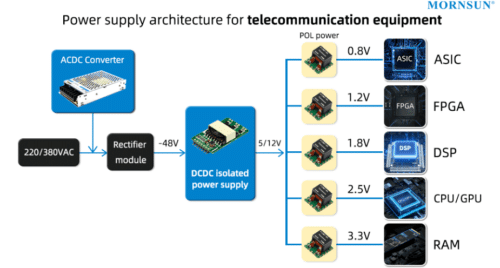1. What is PoL power supply?
PoL power supplies, or point-of-load converters, are used as voltage regulators in distributed power architectures(DPAs) to power microprocessors, ASICs and other digital system components.
Typically, the original power voltage is stepped down by a high power, highly isolated DC/DC converter, and then the voltage is re-converted by the PoL power supply to power the ICs and other low voltage loads. Since a regulated and isolated DC/DC power supply has been used at the front end, so most PoLs do not require isolated voltage regulation at this point. PoL power supplies are usually non-isolated micropower DC/DC power supplies.

2. What are the key parameters to consider when choosing a PoL power supply?
The two-stage voltage conversion described above is a common design concept in power supply design because of its clear and simple design structure, low cost, and its ability to overcome the effects of high peak currents and low noise margins on the performance of high power semiconductor devices, reduce power losses due to voltage reduction, and improve voltage stability, thereby increasing the performance and efficiency of the overall system.
PoL power supplies are so important in complex electronic systems, so how do you choose a PoL power supply? It is important to consider factors such as input and output voltage range, size and efficiency. Pin compatibility also needs to be taken into account. This is explained in more detail below.

- High-current output, high-dynamic load, high output voltage accuracy
The data processing speed of DSP, FPG, ASIC and other high-performance chips is proportional to the required current, so PoL power supplies are required to have a high current output. The chip typically switches rapidly between full-speed operation mode, standby mode and sleep mode, with its clock frequency, core voltage (Vcc) and current changing accordingly, so the PoL power supply must have a high dynamic load capacity. High-end chip ICs, especially those with low operating voltages, require very high stability of the supply voltage, so the power supply for digital systems must have high output voltage accuracy to ensure normal and stable operation of the IC.
- Compact size
As PCB space is usually limited, PoL module power supplies have the advantage of a small layout area compared to discrete solutions. In addition, the resistance of the wires can lead to a reduction in voltage. The smaller the size of the PoL power supply, the closer it can be to the point of load, reducing the length and impedance of the wires and reducing the effects of electromagnetic interference and voltage drop, thus increasing the stability and reliability of the circuit.
- Pin compatibility-DOSA & POLA based
POLA (Point of Load Alliance) and DOSA (Distributed Power Supply Open Standards Alliance) are two product standardization consortia in the power supply industry. Their aim is to achieve pin compatibility between DC/DC products from different manufacturers, flexible interchangeability and reduced deployment risk. Pin-to-pin compatibility means that products can be directly swapped out in the event of design changes or upgrades, avoiding the need to redesign the corresponding circuits and speeding up time-to-market.
- Wide input voltage range
Highly isolated DC-DC power supplies in circuits typically convert mains power to 5VDC or 12VDC, so PoL power supplies are better to have a wide input voltage range to match with both 5VDC and 12VDC inputs from isolated DC/DC power supplies. Choosing a PoL power supply with a wide input voltage range also makes selection easier by accepting different output voltages from the secondary power supply.
- Adjustable output
In a distributed power supply architecture, a PoL power supply is required at the front end of each load. High-end chips such as RAM, FPGAs, CPUs/GPUs, DSPs and ASICs have different input voltages ranging from 0.6V to 5.0V. The adjustable output of the PoL voltage makes it possible to select a PoL power supply that matches the operating voltage range of the different ICs, one for all.
- Low ripple noise
High ripple noise in the PoL power supply may lead to errors such as misjudgments in digital systems processing high-speed pulse signals, or even system crashes.
- High efficiency
Efficiency is also one of the characteristics that should not be overlooked when selecting PoL power supplies. A small amount of inefficiency can accumulate to a large amount and lead to serious heat production, which can affect the reliability of the system and increase the cost of using the system.
- 8)Future trends: digital communication
The rapid development of digital systems has given a strong impetus to the development of PoL power supplies. PoL power supplies with the ability to communicate with other devices are also called digital power supplies. Digital power supplies have the ability to set, regulate and monitor the internal parameters of the power supply with external devices using standard protocol commands such as PMBUS. With such powerful features, digital PoL power supplies are attracting more and more attention






